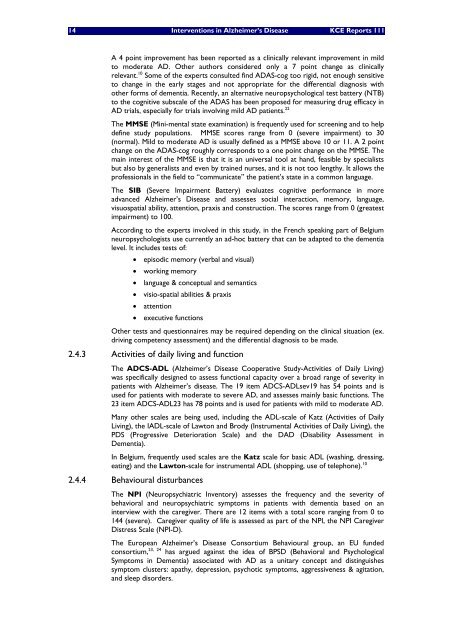Download the full report (112 p.) - KCE
Download the full report (112 p.) - KCE
Download the full report (112 p.) - KCE
You also want an ePaper? Increase the reach of your titles
YUMPU automatically turns print PDFs into web optimized ePapers that Google loves.
14 Interventions in Alzheimer’s Disease <strong>KCE</strong> Reports 111<br />
A 4 point improvement has been <strong>report</strong>ed as a clinically relevant improvement in mild<br />
to moderate AD. O<strong>the</strong>r authors considered only a 7 point change as clinically<br />
relevant. 10 Some of <strong>the</strong> experts consulted find ADAS-cog too rigid, not enough sensitive<br />
to change in <strong>the</strong> early stages and not appropriate for <strong>the</strong> differential diagnosis with<br />
o<strong>the</strong>r forms of dementia. Recently, an alternative neuropsychological test battery (NTB)<br />
to <strong>the</strong> cognitive subscale of <strong>the</strong> ADAS has been proposed for measuring drug efficacy in<br />
AD trials, especially for trials involving mild AD patients. 22<br />
The MMSE (Mini-mental state examination) is frequently used for screening and to help<br />
define study populations. MMSE scores range from 0 (severe impairment) to 30<br />
(normal). Mild to moderate AD is usually defined as a MMSE above 10 or 11. A 2 point<br />
change on <strong>the</strong> ADAS-cog roughly corresponds to a one point change on <strong>the</strong> MMSE. The<br />
main interest of <strong>the</strong> MMSE is that it is an universal tool at hand, feasible by specialists<br />
but also by generalists and even by trained nurses, and it is not too lengthy. It allows <strong>the</strong><br />
professionals in <strong>the</strong> field to “communicate” <strong>the</strong> patient’s state in a common language.<br />
The SIB (Severe Impairment Battery) evaluates cognitive performance in more<br />
advanced Alzheimer’s Disease and assesses social interaction, memory, language,<br />
visuospatial ability, attention, praxis and construction. The scores range from 0 (greatest<br />
impairment) to 100.<br />
According to <strong>the</strong> experts involved in this study, in <strong>the</strong> French speaking part of Belgium<br />
neuropsychologists use currently an ad-hoc battery that can be adapted to <strong>the</strong> dementia<br />
level. It includes tests of:<br />
• episodic memory (verbal and visual)<br />
• working memory<br />
• language & conceptual and semantics<br />
• visio-spatial abilities & praxis<br />
• attention<br />
• executive functions<br />
O<strong>the</strong>r tests and questionnaires may be required depending on <strong>the</strong> clinical situation (ex.<br />
driving competency assessment) and <strong>the</strong> differential diagnosis to be made.<br />
2.4.3 Activities of daily living and function<br />
The ADCS-ADL (Alzheimer’s Disease Cooperative Study-Activities of Daily Living)<br />
was specifically designed to assess functional capacity over a broad range of severity in<br />
patients with Alzheimer’s disease. The 19 item ADCS-ADLsev19 has 54 points and is<br />
used for patients with moderate to severe AD, and assesses mainly basic functions. The<br />
23 item ADCS-ADL23 has 78 points and is used for patients with mild to moderate AD.<br />
Many o<strong>the</strong>r scales are being used, including <strong>the</strong> ADL-scale of Katz (Activities of Daily<br />
Living), <strong>the</strong> IADL-scale of Lawton and Brody (Instrumental Activities of Daily Living), <strong>the</strong><br />
PDS (Progressive Deterioration Scale) and <strong>the</strong> DAD (Disability Assessment in<br />
Dementia).<br />
In Belgium, frequently used scales are <strong>the</strong> Katz scale for basic ADL (washing, dressing,<br />
eating) and <strong>the</strong> Lawton-scale for instrumental ADL (shopping, use of telephone). 10<br />
2.4.4 Behavioural disturbances<br />
The NPI (Neuropsychiatric Inventory) assesses <strong>the</strong> frequency and <strong>the</strong> severity of<br />
behavioral and neuropsychiatric symptoms in patients with dementia based on an<br />
interview with <strong>the</strong> caregiver. There are 12 items with a total score ranging from 0 to<br />
144 (severe). Caregiver quality of life is assessed as part of <strong>the</strong> NPI, <strong>the</strong> NPI Caregiver<br />
Distress Scale (NPI-D).<br />
The European Alzheimer’s Disease Consortium Behavioural group, an EU funded<br />
consortium, 23, 24 has argued against <strong>the</strong> idea of BPSD (Behavioral and Psychological<br />
Symptoms in Dementia) associated with AD as a unitary concept and distinguishes<br />
symptom clusters: apathy, depression, psychotic symptoms, aggressiveness & agitation,<br />
and sleep disorders.

















